by Ian Skellern
Welcome to the 2019 edition of Quill & Pad’s early Grand Prix d’Horlogerie de Genève predictions in which the team picks favorites and explains why.
The panelists are:
Ian Skellern (IS), co-founder and technical director
Joshua Munchow (JM), resident nerd writer
Martin Green (MG), resident gentleman
Sean Li (SL), editorial director of Blackbird Watch Manual
Tim Mosso (TM), watch specialist and media director of pre-owned watch retailer Watchbox
Note: as jury members, editor-in-chief Elizabeth Doerr and resident collector GaryG do not take part in these early predictions.
The GPHG foundation describes the Petite Aiguille category for watches entered as having a “retail price between CHF 4,000 and CHF 10,000. Smartwatches are admissible in this category.”
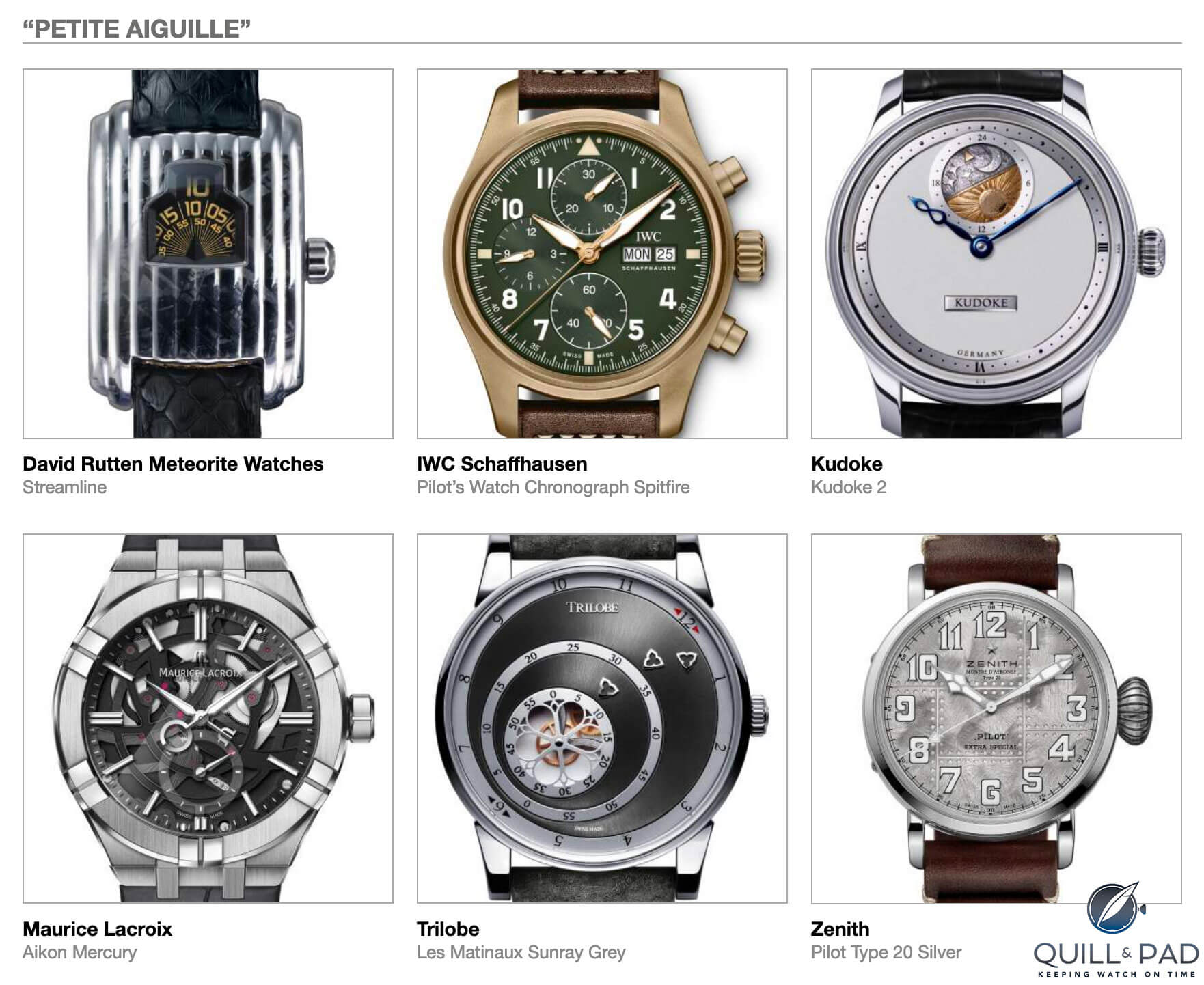
The shortlisted Petite Aiguille watches for the 2019 GPHG from top left: David Rutten Meteorite Watches Streamline, IWC Pilot’s Watch Chronograph Spitfire, Kudoke Kudoke 2, Maurice Lacroix Aikon Mercury, Trilobe Les Matinaux Sunray Grey, and Zenith Pilot Type 20 Silver
MG: “Petite Aiguille” is French for “anything goes as long as it doesn’t cost more than 10,000 but no less than 4,000 Swiss francs” (the Swiss always have a precise command of French). The trouble with this category is that, even more than with other categories, you get a mishmash of entirely disparate watches.
IS: The great thing about the Petite Aiguille category is that, while these are still expensive watches (costing up to around $10,000), they are relatively affordable compared to the watches in all of the other categories (except Challenge). And the great thing about the 2019 pre-selected Petite Aiguille watches is the variety on offer including two pilot’s watches (one a chronograph) and an art deco jump hours. There’s something here for nearly everyone!
JM: Like the Men’s category, the Petite Aiguille has only one rule: to be priced between 4,000 and 10,000 Swiss francs. So other than that, guys, really anything goes. Yet within this price category the offerings are usually fairly standard and sometimes downright snooze-inducing when compared to the entire GPHG lineup.
So whenever there is something outside the norm here, that watch instantly moves up in the rankings for me unless it is lacking in construction quality or is entirely unusable as a watch. Since those don’t usually make it through the pre-selection process, unique watches are usually my favorites, and that is how I help discern between the watches in the Petite Aiguille category.
SL: Allow me a few more moments on the soapbox for this one: I’ve never been fully in agreement with making price a determining factor in the GPHG. The foundation likes to call it the “Oscars of Watchmaking”; well, I’ve not yet seen an Academy Award for “best movie made for a small budget.” Now we have two categories where price is the benchmark?
This is also why I felt that the price shouldn’t even be shown with any of the GPHG watches. However, we do have them, and I’ll talk about the watches presented in the next two categories, which indubitably represent excellent value for money, but could also be worthy entries in some of the previous categories.
TM: This category is split between contenders and also-rans. Trilobe, David Rutten, and Kudoke are standouts; Zenith, Maurice Lacroix, and IWC shouldn’t be here.
David Rutten Meteorite Watches Streamline
SL: Did some research on this one because it’s such a new brand. On the surface, it’s very interesting to be able to propose a meteorite case at such at an aggressive price. But then I found out that this is their way to jumpstart the brand: the initial price, which squeaks in within the parameters of this category, only applies to the first 88 pieces. After that, the price jumps to CHF 16,850. This would make the watch ineligible for the Petite Aiguille. I would say that if this approach is accepted, we’re going to see more of these initial-price watches presented in future, and I’d suggest that this would be a good opportunity for the GPHG to clarify the rules from 2020 onward.
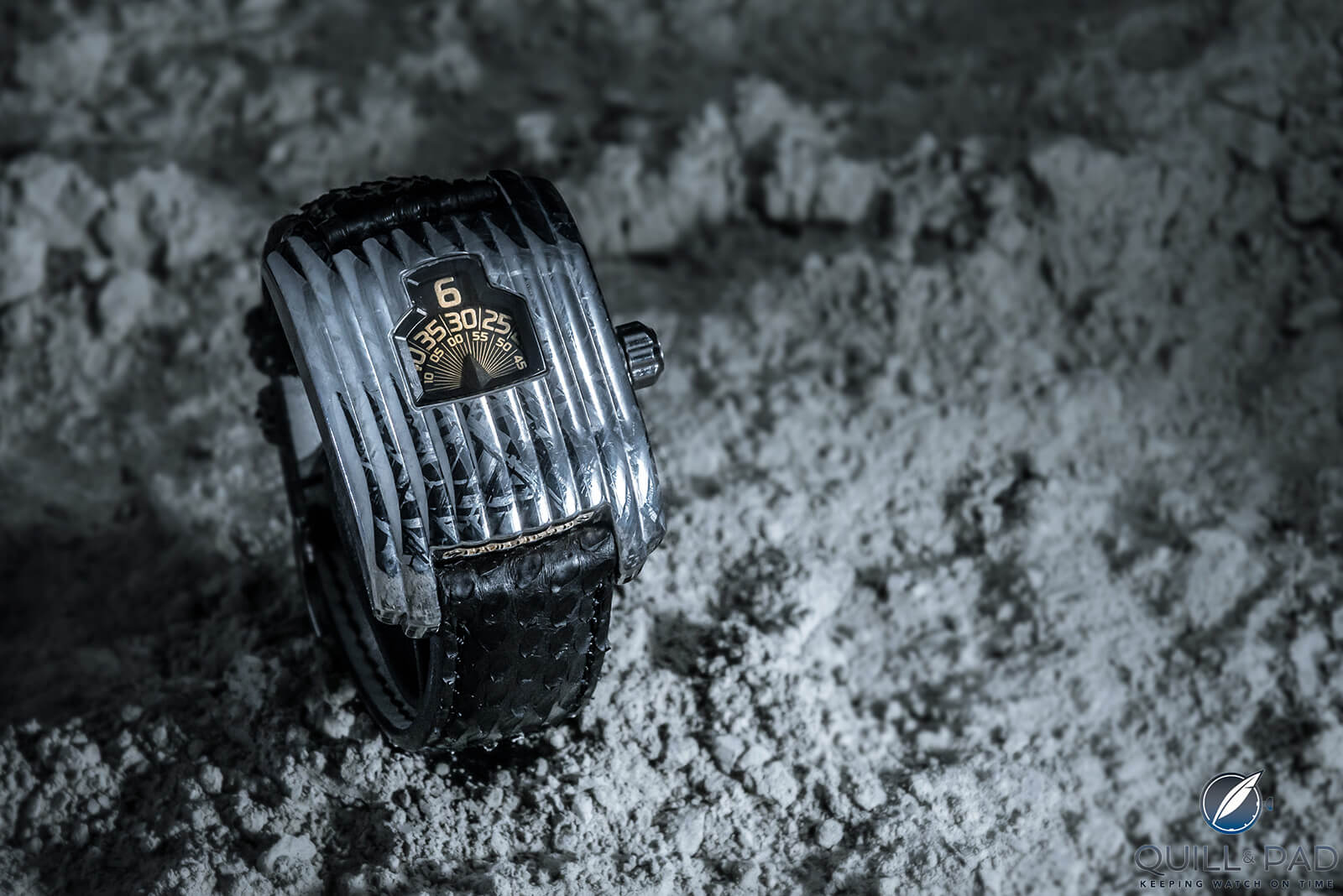
David Rutten Meteorite Watches Streamline
TM: David Rutten’s crazy meteorite-wrapped Streamline jump hour wins my heart and my projection as the category winner. This about as close to Urwerk as you can get for under 10,000 Swiss francs.
First, the case: it’s made of meteorite iron and it’s shaped like the love child of the Chrysler Building and a Raymond Lowey streamline loco. Second, the jump hour is powered by an exclusive caliber with 120 hours of power reserve. This is pure exuberance in form and function; there’s a jubilant authenticity here. You can tell it was conceived by people who love watches.
Even without the meteorite angle, this would be a standout model and one of the most impressive debuts of the year. I hope and foresee that it will win the Petite Aiguille.
JM: It’s pretty easy to love a jump hour watch featuring five days’ worth of power reserve and in an extremely bold art-deco style case made entirely of meteorite. The style is an awesome mix of smooth and hard shapes, and the outline of the display is utterly entrancing as its chiseled into a block of meteorite. I love the vintage color scheme for the display disks and the sharp pyramid acting as an indicator for all three disks (though the hour display doesn’t need one).
The main reason that this watch is my third-place pick and not my first place comes down to the uniqueness of the case (which may not be for everyone) and the layout of the movement on the rear of the case. It is awesome for sure, but given the pedigree and features on some of the other pieces, I think the movement could have used more character to match the case; it feels a little incongruous, and seems like a missed opportunity. When you go wild, there needs to be a reason to hold back elsewhere, and I don’t feel like that has been demonstrated.
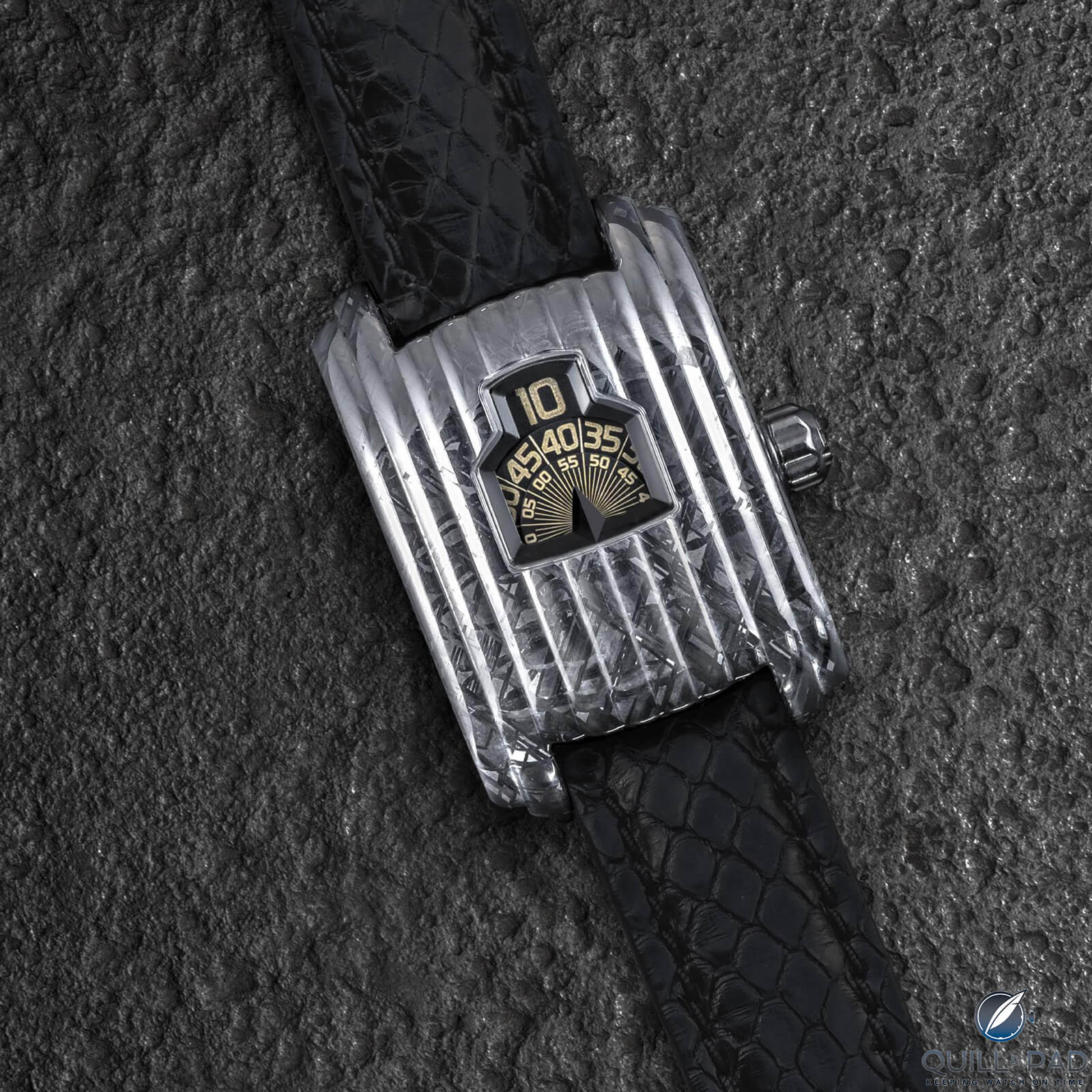
David Rutten Meteorite Watches Streamline
IS: The Streamline is the most idiosyncratic watch in this group and as such it will not suit the majority of tastes but be absolutely perfect for a few. A meteorite shaped case, jumping hours, indications on disks, display back to nice-looking movement, plus a healthy five-day power reserve. And I like the way that the noisy click of the hour jump has been turned into plus – you can hear time passing (like an hour striker). David Rutten has certainly packed a lot into this watch.
For more information, please visit gphg.org/horlogerie/en/watches/streamline.
Quick Facts David Rutten Meteorite Watches Streamline
Case: 37 x 53 x 14 mm, meteorite
Movement: manually wound Caliber DR01 (Christopher Ward/Synergies Horologères SH21 base), 120-hour power reserve, 4 Hz/28,800 vph
Functions: jump hours, minutes, seconds (both on disk)
Limitation: 88 pieces at this subscription price
Price: 9,850 Swiss francs
IWC Schaffhausen Pilot’s Watch Chronograph Spitfire
SL: This watch, or rather its predecessors, always remind me of the continuing debate of in-house vs. ébauche movements. IWC, commendably, has developed its own calibers but has also kept a close eye on making affordable watches, and it must be said that this Spitfire is very good value. The design couldn’t be more classic, the material is perhaps flavor of the day but still popular and does give it a certain vintage look, and the caliber is well proven.
The Spitfire is very much in the spirit of the Petite Aiguille, but it could easily have been entered in the Men’s category. I could’ve also seen it in the Iconic category, it’s much more linked to IWC in collectors’ minds than the Pallweber.
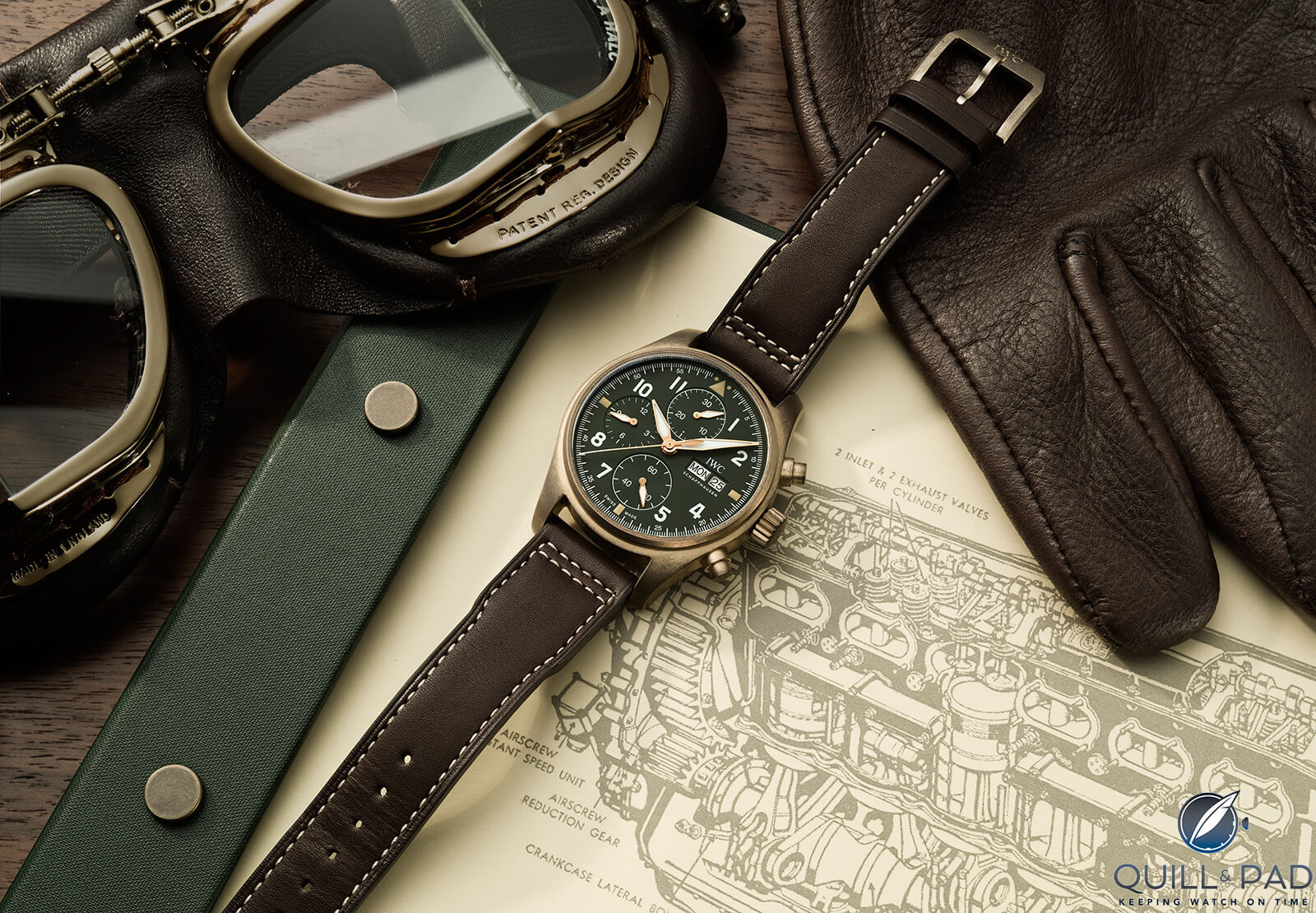
IWC Schaffhausen Pilot’s Watch Chronograph Spitfire
TM: IWC’s Pilot’s Watch Chronograph Spitfire is a competent and attractive product at CHF 6,800. The inclusion of IWC’s own 69380 movement adds value, and the 41 mm size is versatile.
All of that said, the world doesn’t need another bronze watch. Eight years removed from the landmark Panerai PAM 382, bronze watches – especially with green dials – have become a cliché. We need new ideas, and even IWC’s handsome execution of an old idea isn’t fresh enough to be an award contender.
JM: I can’t say anything bad about this watch, it is a terrific chronograph with day and date, has a classic dial layout, an interesting bronze case for character, and comes in at a very good price point. Out of the releases from IWC this last year, this piece was a real winner and fits right in the sweet spot for a lot of collectors.
Yet among the other pieces it feels a bit like the dad in the room. It’s dependable, responsible, won’t embarrass itself among any of its peers, and understands that you don’t need to throw money away on something fancy to get exactly what you need. And that is why I don’t know if it should win: it’s predictable. This shouldn’t be taken as a hit against the watch, but just like the Academy Awards, the GPHG demands boundary pushing and risk taking, even in the moderately priced category Petite Aiguille. This is the watch that Gotham needs, but I don’t know if it is the watch it deserves.
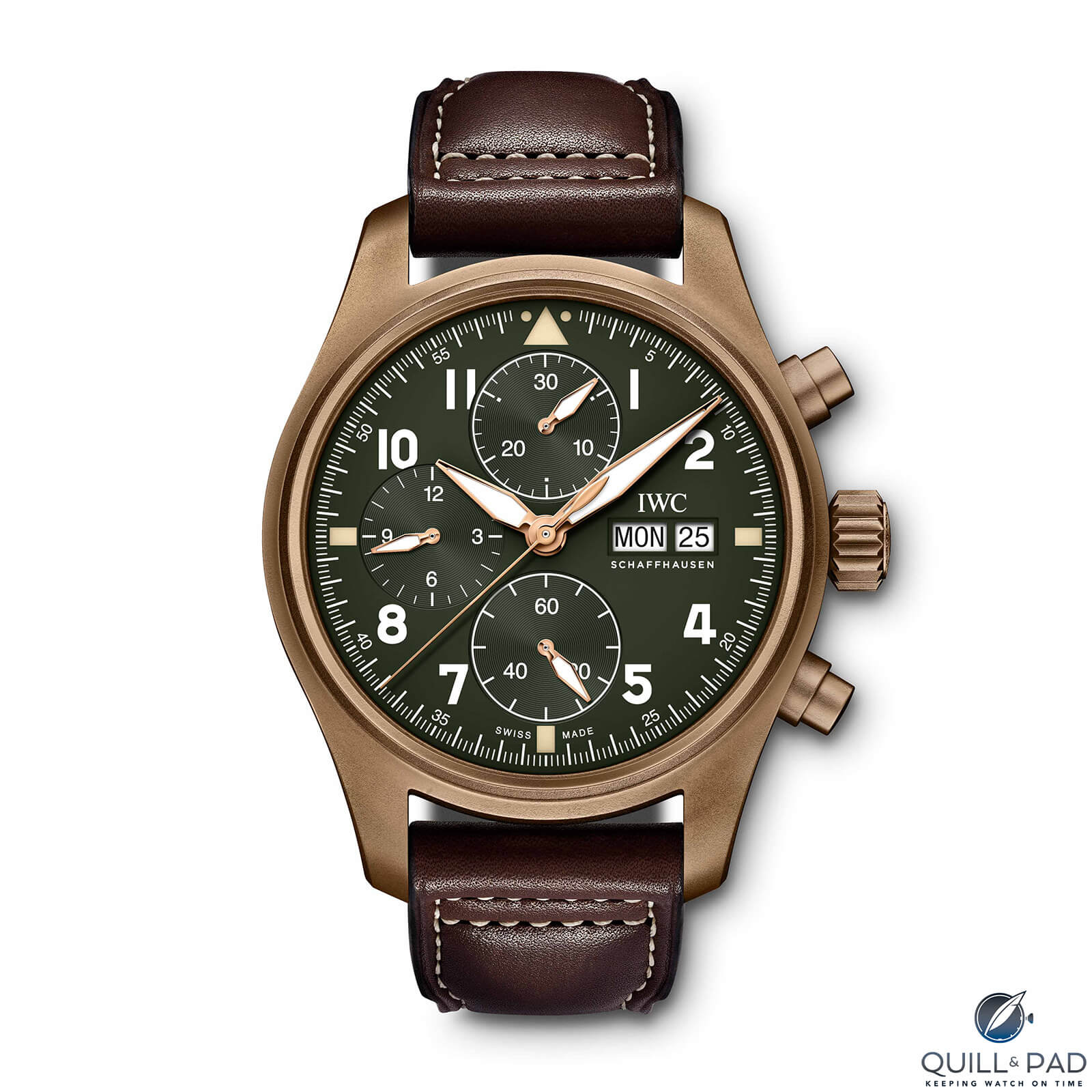
IWC Schaffhausen Pilot’s Watch Chronograph Spitfire
IS: The IWC looks to offer the best value for money in this group. Hours, minutes, seconds, date, day, automatic in-house column wheel chronograph, highly legible indications, a very wearable 41 mm case and a great looking watch, all for 6,800 Swiss francs (roughly the same in USD). For value for money, the Chronograph Spitfire will be hard to beat and is my pick for the 2019 Petite Aiguille.
For more information, please visit gphg.org/horlogerie/en/watches/pilots-watch-chronograph-spitfire.
Quick Facts IWC Schaffhausen Pilot’s Watch Chronograph Spitfire
Case: 41 x 15.3 mm, bronze with soft iron core for magnetic field protection, titanium case back
Movement: automatic Caliber 69380, 4 Hz/28,800 vph frequency, 46-hour power reserve, column wheel chronograph
Functions: hours, minutes, hacking seconds; date, day, chronograph
Price: €7,050 / 6,800 Swiss francs
Kudoke Kudoke 2
SL: So good, they named it twice! But seriously, this is also a lot of watch for the money. I like the fact that Stefan Kudoke has kept hand-finishing like this within reach of a wider range of collectors’ budgets. I also like the clean aesthetic; the blued hands are always a crowd pleaser.
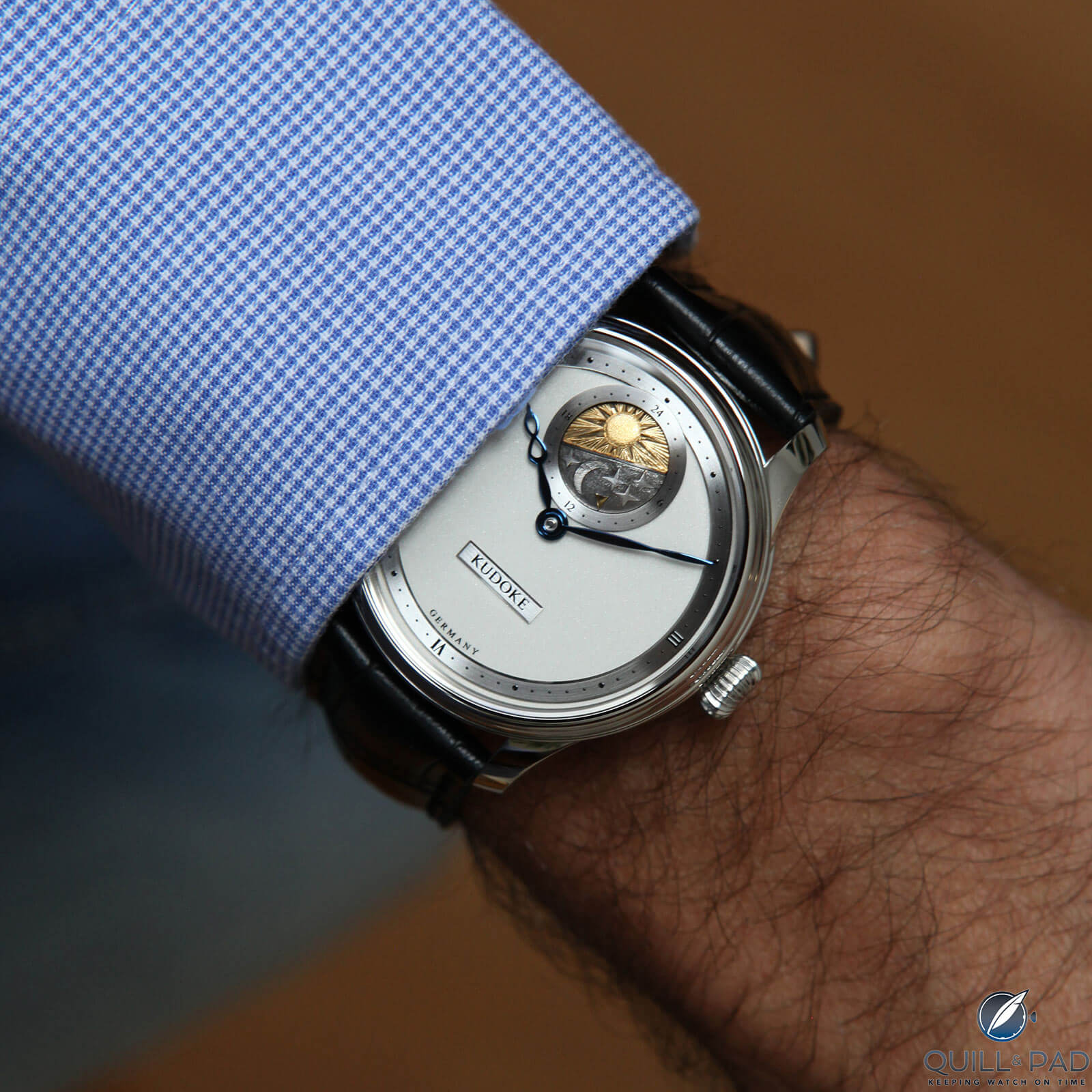
Kudoke 2 on the wrist
IS: While not the only watch by an independent brand here (impressively, indies make up half of the pre-selected watches this year), the Kudoke 2 is a true independent watchmaker enthusiast’s watch. The beautiful minimalist dial is punctuated by those elegant blue hands and intricately engraved rotating sky disk at 12 o’clock. The hand-finishing is superb, and the modified Habring2 movement reinforces the independent quality of the watch. I’m not sure that the jury will agree, but the Kudoke 2 is the watch I would buy for myself from this lineup.
JM: On the surface the Kudoke 2 seems like it lacks a defining feature to be a standout, even in a category where price is the only requirement. Yet when one looks closer it becomes clear that in a world of mass-produced watches with perfect, machine-made components, this is a piece that features traces of handmade charm.
Of course that is also no reason to win a category, but I feel this watch has a perfect combination of style and details to win over a crowd. This is especially true when you look at the movement from the rear and see a huge engraved balance cock and two wheels of the winding mechanism centered in the massive expanse of a full-plate movement, only opening enough to expose the balance wheel.
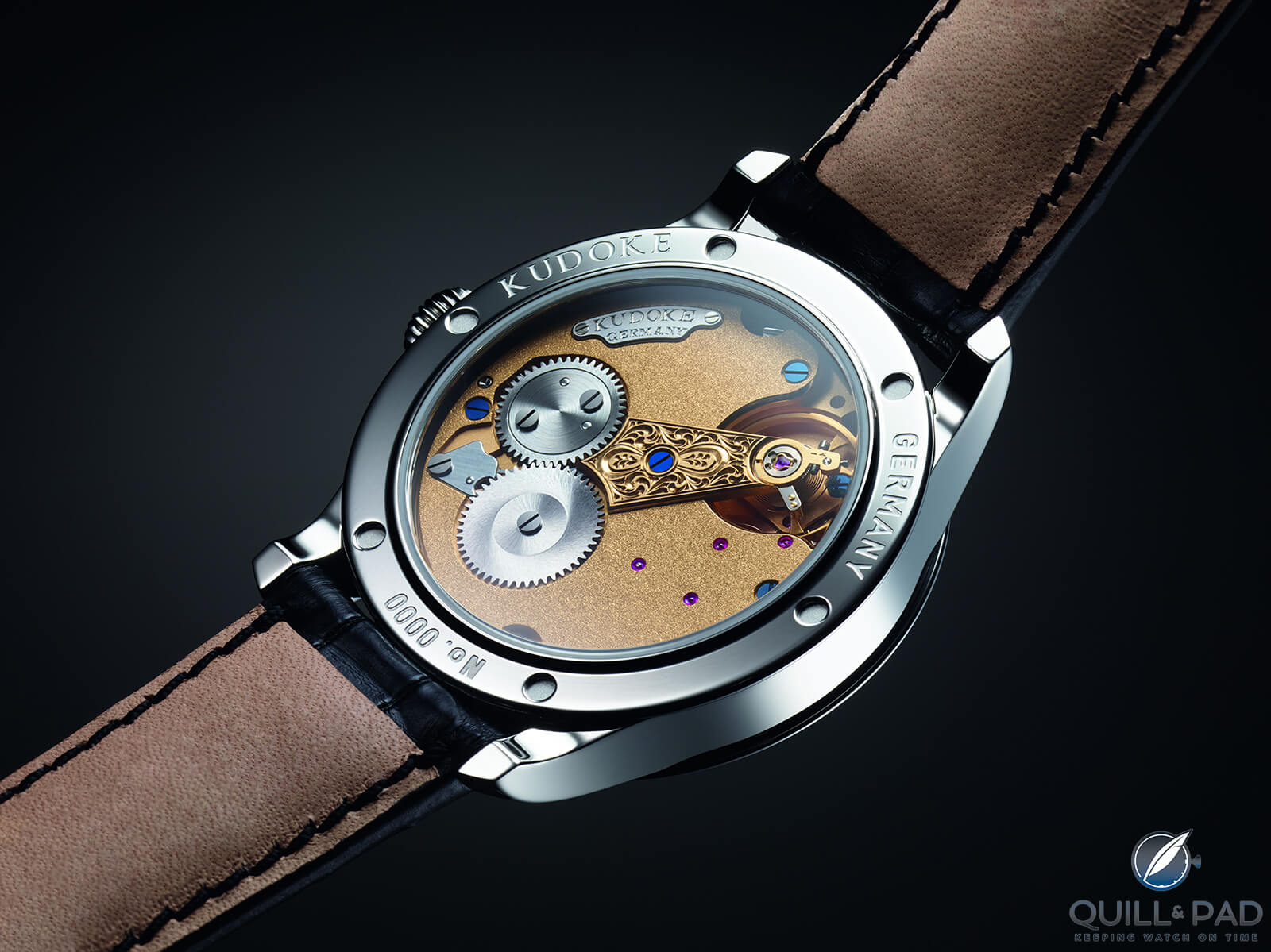
Back of the Kudoke 2
The finishing is awesome and simple, and the clean dial with hand-engraved 24-hour disk on the front is a very attractive combination. Against a few more industrialized models like the Zenith, IWC, and Maurice Lacroix, the Kudoke stands out as having everything that makes a great basic watch with a healthy dose of real charm and takes the top spot in my book.
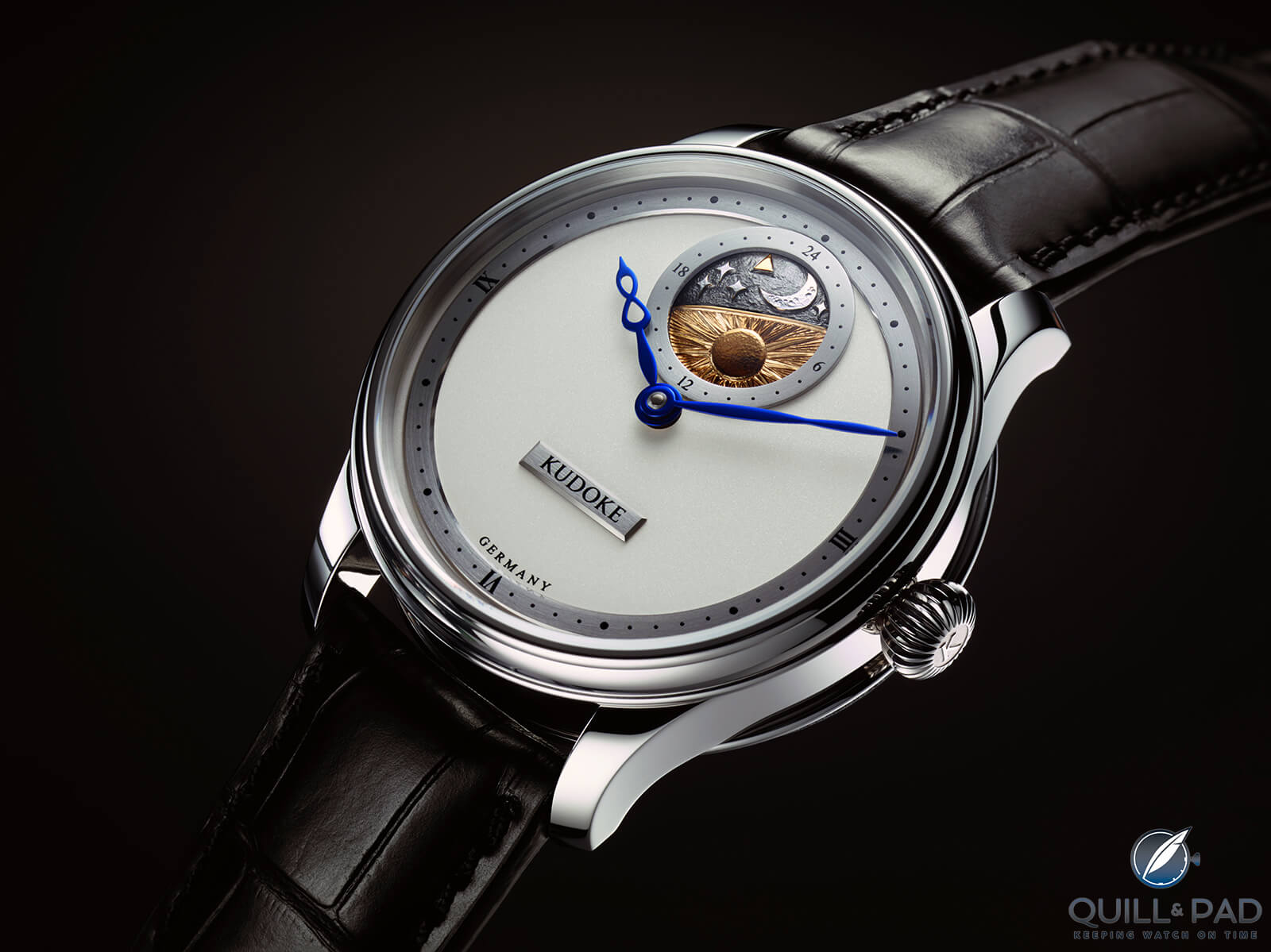
Kudoke 2
TM: Stefan Kudoke’s Kudoke 2 has a strong claim to the Petite Aiguille award. The watch is distinctively different without trying too hard; it is impressively finished inside and out; the dial is clean; the details pop. Kudoke succeeds by combining a reserved overall design with decadent details.
Hand-finished details in a sub-$10,000 watch are treasures. In that regard, the Kudoke 2 is like an English pirate ship fresh from a raid on the Spanish Main. A day-night disk at 12 o’clock provides 24-hour clarity while showcasing Kudoke’s distinctive engraving technique. The movement is based on the architecture of another caliber, but its decoration style and quality are emblematic of Kudoke’s ingenuity and standards. And 39 mm is a perfect size for 2019.
Few watches at even double the price offer this much gratification to owners of fine loupes. If Kudoke wins, I’ll smile as though I had called the shot myself.
Further reading: Kudoke 2 By Stefan Kudoke: Handcrafted Movement, Artistic Dial, Sensational Value
For more information, please visit gphg.org/horlogerie/en/watches/kudoke-2.
Quick Facts Kudoke Kudoke 2
Case: 39 x 10.7 mm, stainless steel
Movement: manually wound Kaliber 1 (Habring2 A11B base), 4 Hz/28,800 vph frequency, 46-hour power reserve, amagnetic escapement with Carl Haas balance spring
Functions: hour, minute; day/night indication, 24-hour indication
Price: €7,807 / $8,870 / CHF 9,670 (all prices without VAT)
Maurice Lacroix Aikon Mercury
IS: I like the playful nature of the Aikon Mercury with its hands rotating freely until required to indicate the time. While I’m a fan of open dials revealing the movement below, the dial looks too busy for me and I’m not sure (from the photos) if legibility will be an issue.
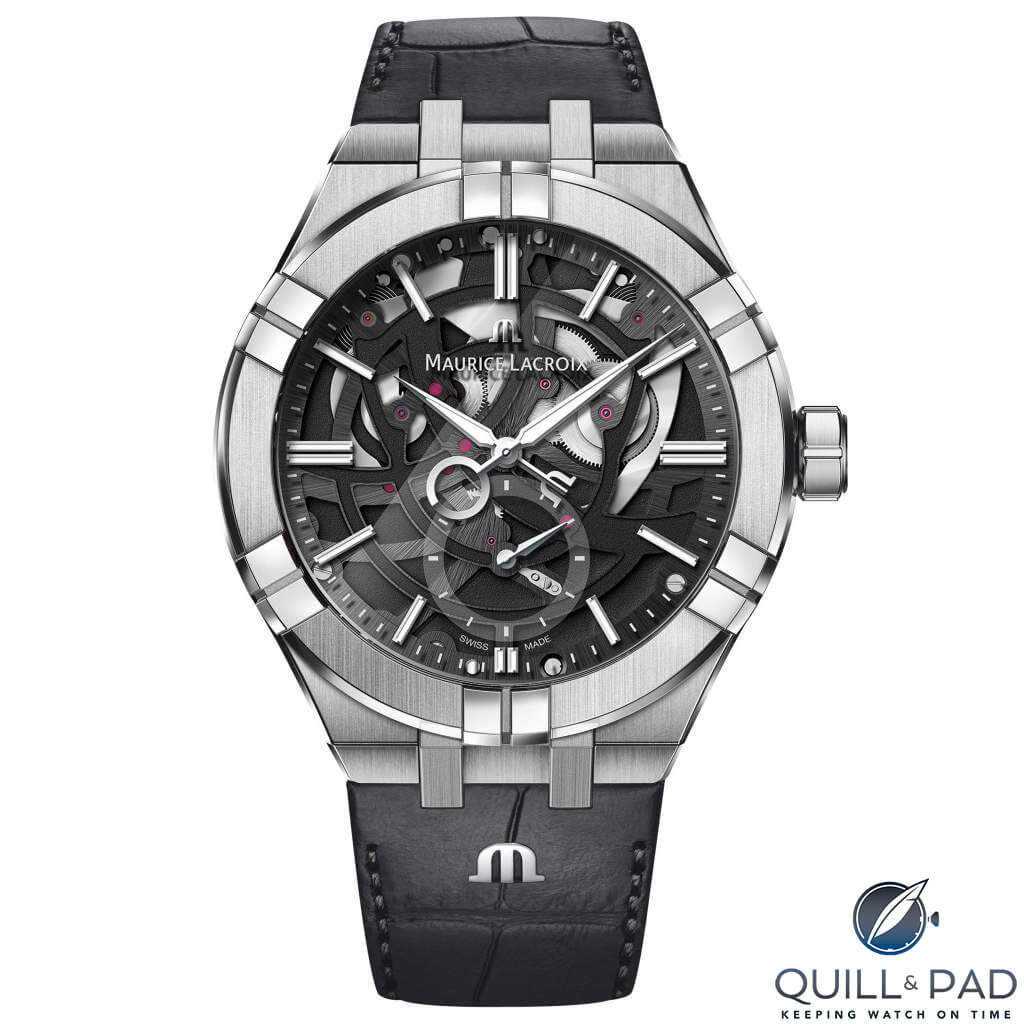
Maurice Lacroix Aikon Mercury
SL: This watch shows that you can also get some mechanical innovation without breaking the bank. I’d urge readers to seek out videos of the watch and not rely on static images alone because it has an interesting and quirky mechanism with hands that appear loose but will lock into place, and the correct time, when you turn your wrist. Probably not the best watch to have on your wrist if you’re trying to discreetly check the time during an interminable meeting, though.
TM: Maurice Lacroix is a competent brand that balances manufacture movement products with an array of well-made vehicles for custom calibers.
The Aikon Mercury falls into the latter category, but it adds a set of freewheeling hands. When the watch is held flat or tilted away from the user, the hands begin to spin in random directions. When the watch is held erect with its dial vertical, the hands return to indicating the time. If that sounds a bit like a gimmick, you’re wrong: it is the literal definition of a gimmick.
At 44 mm, this watch is too large, and without a compelling innovation it shouldn’t win any awards.
JM: Talk about a watch that could have benefited from a bit more refinement in the design stage and a dose of restraint on the dial skeletonizing (or complete elimination of it) . . . this watch feels exactly like it is described by Maurice Lacroix: a watch that returns to design codes of the 1990s, but unlike the brand I don’t think that is a good thing.
The ’90s are well known for being the decade where everyone finally had computer software for design use and most didn’t quite understand why that didn’t necessarily change what was good design. Just because it is easy to add a few lines here and draw some arcs there doesn’t mean it is suddenly a cohesive design strategy. The watch feels not timeless but so entirely constrained to a point in time that it feels out of place now, and I don’t think it can take this category unless the other five dropped out due to a stomach flu (watches can get the flu, right?).
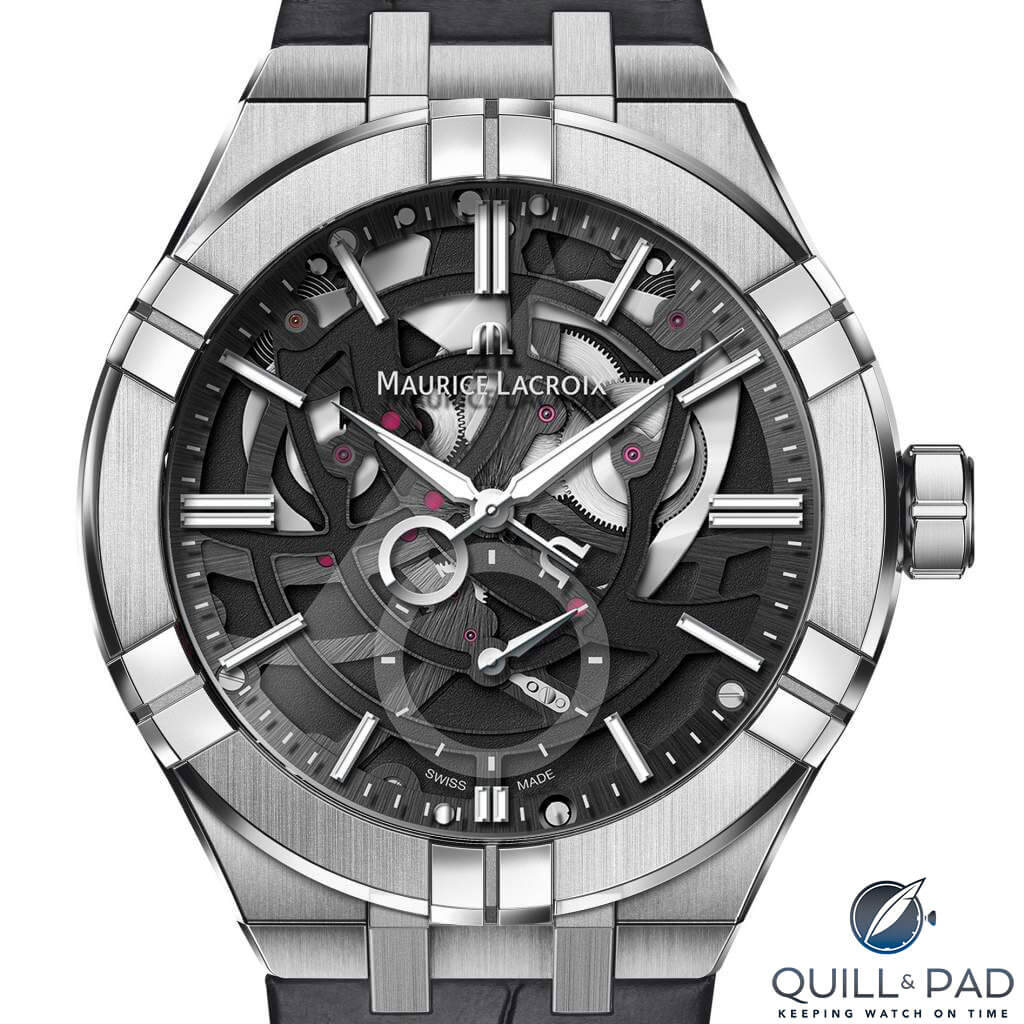
Maurice Lacroix Aikon Mercury
Honestly, the design completely distracts from the very cool engineering feature with the “Free Hand” system, something that could have taken this watch into the running or even made it the winner if I wasn’t so turned off by the styling. Maurice Lacroix has made some very cool mechanical features in the past, and if this was presented similarly to some of those it could have been a fantastic watch.
MG: This complication is so utterly useless, yet such incredible fun! Just enjoy the smooth motion of the hands wandering across the dial until you turn your wrist and they snap to attention at the right time. I can do this over and over and over again. Yes, in fact I could live happily with this Maurice Lacroix on my wrist, and the longer that I am in watch journalism this seem to happen on less and less occasions, so I have to follow my gut on this one and call it my winner!
Further reading: Maurice Lacroix Masterpiece Mystery And The Solar System
For more information, please visit gphg.org/horlogerie/en/watches/aikon-mercury.
Quick Facts Maurice Lacroix Aikon Mercury
Case: 44 x 14 mm, stainless steel
Movement: automatic Caliber ML225 (base Sellita SW 200) with patented “time memory module,” 4 Hz/28,800 vph frequency, power reserve 36 hours
Functions: hours, minutes, seconds with “free hand” system
Price: 7,500 Swiss francs
Trilobe Les Matinaux Sunray Grey
JM: With a movement module developed under the tutelage of Jean-François Mojon, you know this watch is going to be something special. The Trilobe concept is clean and perfectly executed, providing a very distinct way of reading the time. A window into the movement provides the smallest hint at what is working within, but it does not give away what the mechanics truly are. I love the display and regulator-esque differentiation but have some issues with the distribution of the indicators and lack of either symmetry or purposeful asymmetry. I also usually love monochromatic watches, but it does feel like some more contrast would make for a more convincing piece.
Still, I have to choose this for my second place because I think it could be a very well received piece for a wide variety of people looking for something a bit different in this price range.
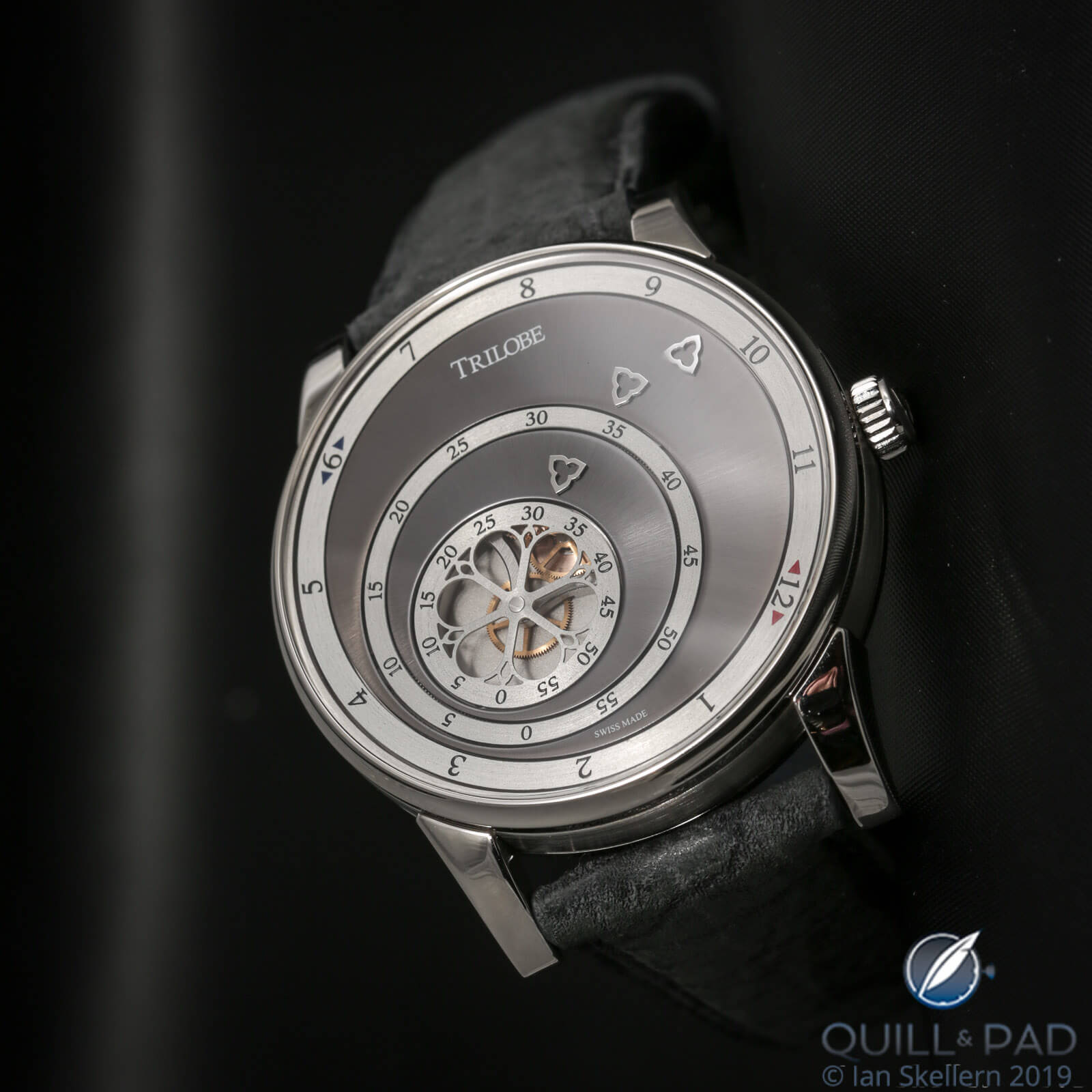
Trilobe Les Matinaux Sunray Grey
TM: Trilobe deserves credit for proposing a new concept with the Les Matinaux. The rotating ring displays are fun, unconventional, and less chaotic than some alternate time displays (Genus, I’m looking at you).
The Trilobe’s 40.5 mm case is on point for this era, and Mojon’s involvement in developing the module adds gravitas to the sales pitch. Potential weaknesses include legibility and the formidable cost of what is, fundamentally, an ETA 2892-powered machine.
For under 7,500 Swiss francs, Trilobe’s Les Matinaux is an enjoyable diversion from the usual dress three-handers, dive watches, and pilot’s models that seem to dominate the middle of the luxury market. In a less competitive year, the Trilobe might have been a favorite to win the hardware.
SL: I came across this brand a few months ago, and while I applaud its innovation, I can’t help but think that the designers are still rather young and haven’t had anyone around them afflicted with presbyopia; I’d like to be able to tell the time, and I would’ve liked to see the design not relying on requiring me to wear my glasses or to squint in order to do so. The numerals are way too small. I hope that the future versions of this watch can cater to those with eyes that are too lazy to focus properly.
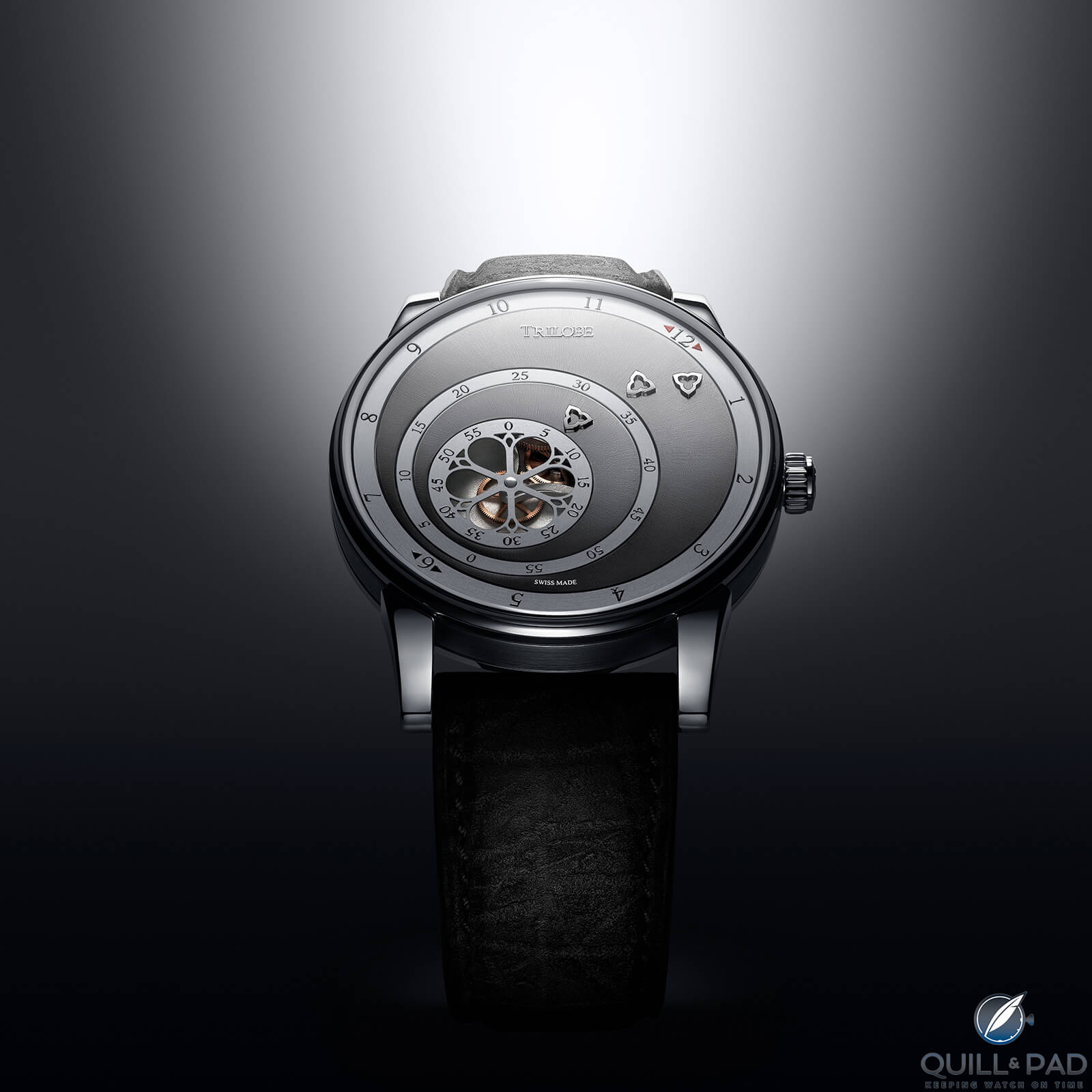
Trilobe Les Matinaux Sunray Grey
IS: Trilobe was one of the sleeper hits for me at Baselworld this year. I liked both the poetic concept and execution. While rotating disk indications are often not intuitive, I find the Trilobe dial easy to read. I think Les Matinaux Sunray Grey well deserves its inclusion here.
For more information, please visit gphg.org/horlogerie/en/watches/les-matinaux-sunray-grey.
Quick Facts Trilobe Les Matinaux Sunray Grey
Case: 40.5 x 10.25 mm, stainless steel
Movement: automatic Caliber ETA 2892, highly modified, 4 Hz/28,800 vph frequency, 42-hour power reserve
Functions: hours, minutes, seconds
Price: 7,375 Swiss francs
Zenith Pilot Type 20 Silver
SL: It’s interesting to see how polarizing this particular iteration of the Zenith Pilot has been. The brand has certainly been developing this collection for a few years now, and using silver for the case and dial has made this model stand out in quite a crowded market. There are, of course, questions about how the silver will age over time, which is also part of its appeal, I’d be curious to see examples of this watch after they’ve been worn for a few months or even years.
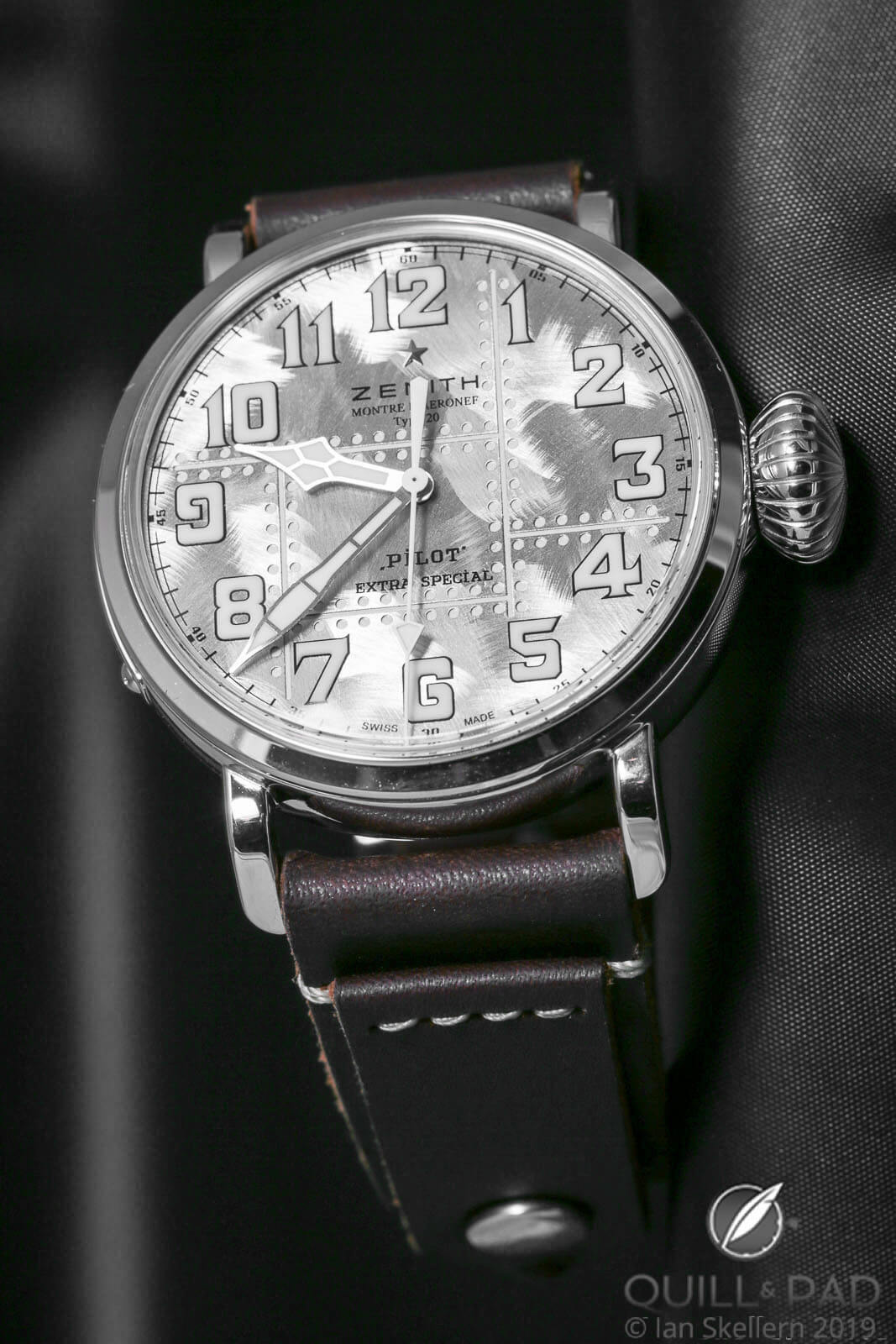
Zenith Pilot Type 20 Silver
JM: I feel like the Zenith Pilot Type 20 is a great watch . . . from half a decade ago. Now it has become an average watch with a slightly larger-than-average diameter now that sizes have trended smaller again. It feels like it is still in the collection not because it is serving a definite function but because discontinuing a (likely) popular model is analogous to telling your customers you are bored with their money.
It is kind of like the Patek Philippe Calatrava: an objectively good watch that is so intimately tied to your brand identity that you would never consider getting rid of it, but even the name feels a bit stale on the tongue. How many are truly energized and excited by the Type 20 considering the other offerings from Zenith? I understand entries for the GPHG are also marketing-goal related, but I would have picked something like the new Defy Classic in blue ceramic for more of a splash in this category.
TM: Zenith deserves credit for providing the latest wristwatch resurrection of sterling silver. This occasional metal was a mainstay of the pocket watch era, but it nearly vanished with the arrival of wristwatches and reliable stainless-steel alloys. On that count, the Zenith Pilot Type 20 Silver is a standout.
In every other regard, this is a variation on an existing watch. The rivet-style dial screams “Ford Trimotor” – which is cool – but dial and case metal variations are the branding equivalent of “playing out the string” with an aging product. And 250 pieces seems like a lot for a watch that’s supposed to be exclusive. I like it, but I don’t love it.

Zenith Pilot Type 20 Silver
MG: I enjoy it very much that Zenith has introduced a watch made of silver. There was a time when this material was quite common for watch cases, but the use of it in watchmaking has almost completely stopped. Combined with the dial I think that this is a very strong design.
IS: Looks might not be everything, but in the case of the Zenith Pilot Type 20 Silver they certainly make up a significant percentage of the attraction. The dial works for me, I love the color, patterns, finishes, hands and numerals, those dotted lines, and the large onion crown. While 45 mm is too large for me, this is a pilot’s watch and the legibility that a large diameter offers is inherent to the genre. The Zenith Pilot Type 20 Silver is my runner-up in this category.
For more information, please visit gphg.org/horlogerie/en/watches/pilot-type-20-silver.
Quick Facts Zenith Pilot Type 20 Silver
Case: 45 x 14.25 mm, silver
Movement: automatic Zenith Elite Caliber 679, 4 Hz/28,800 vph frequency, power reserve 50 hours
Functions: hours, minutes, seconds
Limitation: 250 pieces
Price: 8,500 Swiss francs
Predicted Winners
Martin: Maurice Lacroix Aikon Mercury
Tim: David Rutten Meteorite Watches Streamline
Joshua: Kudoke 2
Sean: IWC Schaffhausen Pilot’s Watch Chronograph Spitfire
Ian: IWC Schaffhausen Pilot’s Watch Chronograph Spitfire
You may also enjoy:
Our Predictions In The Ladies Category Of The 2019 Grand Prix d’Horlogerie de Genève (GPHG)
Our Predictions In The Chronograph Category Of The 2019 Grand Prix d’Horlogerie de Genève (GPHG)
Our Predictions In The Artistic Crafts Category Of The 2019 Grand Prix d’Horlogerie de Genève (GPHG)
Leave a Reply
Want to join the discussion?Feel free to contribute!





















































Tim, did you write this before agreeing with Roger Ruegger that the Kudoke should win?
For me the selection is strange. I hope one of the 3 adventurous dials gets the prize.
I wish the kudoke was a reverse watch as the back side shows a very eye catching movement.
I’ll cast a vote for rutten for a courageous design down to “aged” numerals on the dial.
I love the art deco flavor of David Rutten, followed by Kudoke.
As one of the reviewers here pointed out, the David Rutten isn’t really qualified for the category, as it only fits at its limited discount pricing, and then skyrockets above the upper limit of the category. The Kudoke 2 is the only watch I’d buy here — been on my list for about a month now.
I agree entirely, though it would have been more impressive at 42mm.